Marijuana has been used to treat a wide assortment of medical conditions for thousands of years. Only in the last few decades have we begun to understand why this plant is such a miracle medicine. Cannabis contains many compounds that are unique to the plant, collectively these are referred to as cannabinoids. A cursory understanding of the predominant cannabinoids may assist in choosing the correct cannabis to treat your medical condition.
It is important to understand that various cannabinoids interact with each other, tempering or amplifying the psychoactive effects. For this reason, one cannot always predict the effects of a prospective strain simply from reviewing lab results.
While in no way a complete list, the following cannabinoids are known to have medicinal benefits. In total there are over 85 know cannabinoids in marijuana, and there is still much research that needs to be done. As research continues, we expect to find that many other cannabinoids have medicinal applications. At this time we must work with data that is available.
Δ9-Tetrahydrocannabinol-Acid (THCA)
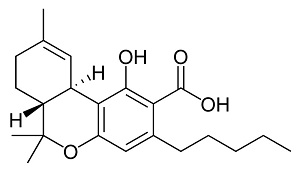
Δ9-THCA-C5
THCA is the most common form of THC found in raw marijuana samples. THCA readily converts to Δ9-THC after application of heat or chemical catalyst. This non-psychoactive form of THC can be of great medicinal value by; reducing inflammation, reducing muscle spasms and even suppressing the growth of tumors.
Tetrahydrocannabinol (THC)
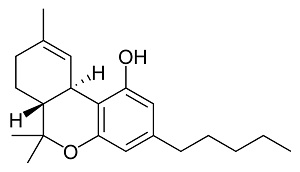
Δ9-Tetrahydrocannabinol-C5
The primary cannabinoid in most modern strains, tetrahydrocannabinol (THC) is responsible for most of the psychotropic effects associated with marijuana. It is for this reason that breeders have focused on creating high THC strains.
THC is the only cannabinoid known to stimulate appetite, which makes it invaluable for patients treating nausea. THC has the ability to treat pain for a very wide array of medical conditions. In addition to its mild analgesic effects, THC can induce a state of mind wherein discomfort can be more easily managed. THC has also been shown to be a powerful antioxidant.
THC is known to amplify anxiety in some patients. Medicinal marijuana users who suffer from this condition should look for strains with lower THC content that favor CBD.
Cannabidiol (CBD)
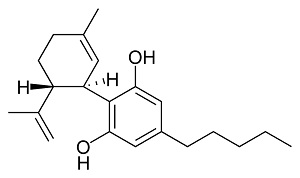
(−)-Cannabidiol CBD-C5
Cannabidiol (CBD) is a non-psychoactive cannabinoid that has shown great potential in a wide array of medicinal settings. CBD has been specifically bred out of many modern marijuana strains, as recreational users tend to prefer strains high in the psychoactive THC. Research has indicated that CBD can also reduce the psychoactive effects of THC.
New research has shown that CBD may actually inhibit the growth of cancer cells, and indicates CBD is a powerful anti-inflammatory. This new understanding of CBD is leading the way to a renaissance in the marijuana industry. As physicians, patients and breeders begin to understand the value of CBD, new strains with higher CBD levels are quickly gaining popularity.
Cannabidiol-Acid (CBDA)
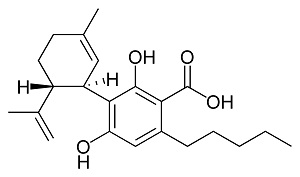
CBDA-C5
Fresh marijuana samples contain the bulk of their CBD in the form of its acid CBDA. Like THCA, CBDA requires the application of heat or a chemical catalyst to convert into CBD. Being non-psychotropic, CBDA is a powerful anti-inflammatory without the side effect of intoxication.
Cannabinol (CBN)
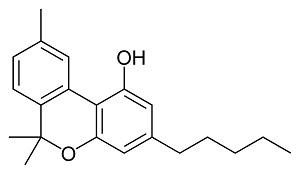
CBN-C5
The product of decaying THC, the cannabinoid CBN is uncommon in fresh marijuana.
Upon consumption, CBN interacts with the remaining THC and amplifies its psychotropic effects. The effects of CBN are commonly described as sedative and can be helpful for those treating some sleeping disorders.
The Right Cannabinoids for You
In October 2009, TRENDS in Pharmacological Sciences published an incredible amount of data on the treatment of ailments and diseases using specific cannabinoids. The table below offers a summary of these findings.
| THCA | THC | CBN | CBDA | CBD | |
|---|---|---|---|---|---|
| Pain relief | x | x | x | ||
| Reduces inflammation | x | x | x | ||
| Suppresses appetite | |||||
| Stimulates appetite | x | x | |||
| Reduces vomiting & nausea | x | x | |||
| Reduces contractions in small intestine | x | ||||
| Relieves anxiety | x | ||||
| Tranquilizing, used to manage psychosis | x | ||||
| Reduce seizures and convulsions | x | x | |||
| Suppresses muscle spasms | x | x | x | ||
| Aides sleep | x | ||||
| Reduces efficacy of the immune system | x | ||||
| Reduces blood sugar levels | x | ||||
| Reduces nervous system degeneration | x | ||||
| Treats psoriasis | x | ||||
| Reduces risk of artery blockage | x | ||||
| Kills or slows bacteria growth | x | ||||
| Treats fungal infection | |||||
| Inhibits cell growth in tumors/cancer cells | x | x | x | ||
| Promotes bone growth | x |
While the evidence to support the medicinal qualities of cannabis are piling up, doctors of western medicine warn patients that cannabis should in no way take the place of traditional western medical practice. It is always advised that you consult a physician before taking marijuana for any reason.
Understanding Cannabinoids,

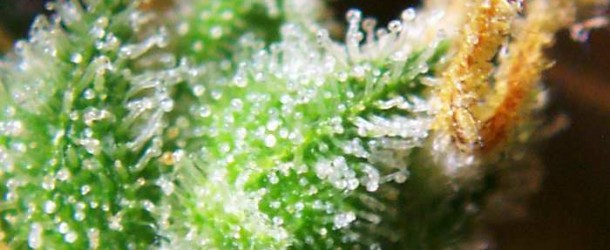







I, for one am very exited about high CBD content strains. I am growing mostly these strains. Harlequin, Cannatonic, Juanita is my favorite. Virtually no THC and very high CBD content. I believe that the future of this industry resides in the medicinal values of this amazing plant. Stoners will be stoners and there will always be places for them to get high. The patients who are in real need of quality medicine deserve access to medical marijuana, use it, without getting high. Most patients are looking for relief AND clarity. Not everybody wants to get high at 8.00 in the morning!
where did you find Harlequin seeds? I have had no luck.
You probably won’t have much luck finding seeds. Mostly likely you’ll have to buy clones. I know they can be found in CA